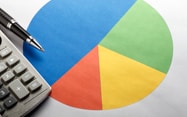Esta página de Internet está disponible sólo en inglés. Sin embargo, tenemos otros materiales de educación financiera en español.
How to create a budget
Putting it all together in a budgetMost people know they need a financial budget. But when it comes time to create one – and then stick to it – it can be tough to get started.
 Whether you’re creating a budget for the first time or simply need a refresher course, here’s a step-by-step guide to get you started:
Whether you’re creating a budget for the first time or simply need a refresher course, here’s a step-by-step guide to get you started:
Step 1: Organize your financial documents.
At its core, a budget is a worksheet with separate categories for income, expenses, and savings. So, you’ll need to gather your financial documents, such as pay stubs, credit card and bank account statements, and auto or student loan bills, to ensure you have enough information to get started.
Step 2: Track your monthly expenses.
For one month, keep a detailed log of your spending. Track all your expenses, ranging from larger expenses, such as car, rent, mortgage, or credit card payments down to the amount you spend on daily lunches, or other incidental expenses. Consider using online tools, such as Budget Watch, to automate the process of tracking your spending and setting up budget goals.
Step 3: Analyze your income and expenses.
At the end of the month, total your income and your expenses and then subtract your expenses from your income. If it doesn't seem right, check that you've captured all of your income and expenses. If your income or expenses change each month, that can have a major impact on your budget. If your expenses add up to less than your income, you’re on the right track. If not, examine your spending with two questions in mind: "What can I do without?" and "What’s really important?"
Step 4: Categorize and budget your expenses.
After looking at all of your expenses, separate them into categories and set a budget for each. If you think you spend too much in a given area, set a goal that will prompt you to actively make changes.
Step 5: Review your budget monthly.
Make a habit of reviewing your budget every month, particularly in the early stages. It’s also helpful to get a qualified second opinion. That might come from a trusted friend or relative who’s skillful with spending, savings, and investing. It could also come from an experienced financial planning professional who can review your budget, offer suggestions and help answer questions.
Tip
There will be emergencies and events that may divert you off your target every once in awhile. But if you make budgeting a regular habit, you’ll have the tools you need to adjust your spending and get back on track.
Empower yourself with financial knowledge
We’re committed to your financial success. Here you’ll find a wide range of helpful information, interactive tools, practical strategies, and more — all designed to help you increase your financial literacy and reach your financial goals.
Products to Consider
Wells Fargo Bank, N.A. Member FDIC.
QSR-06032026-7405092.1.1
LRC-1224

 Sign On
Sign On 